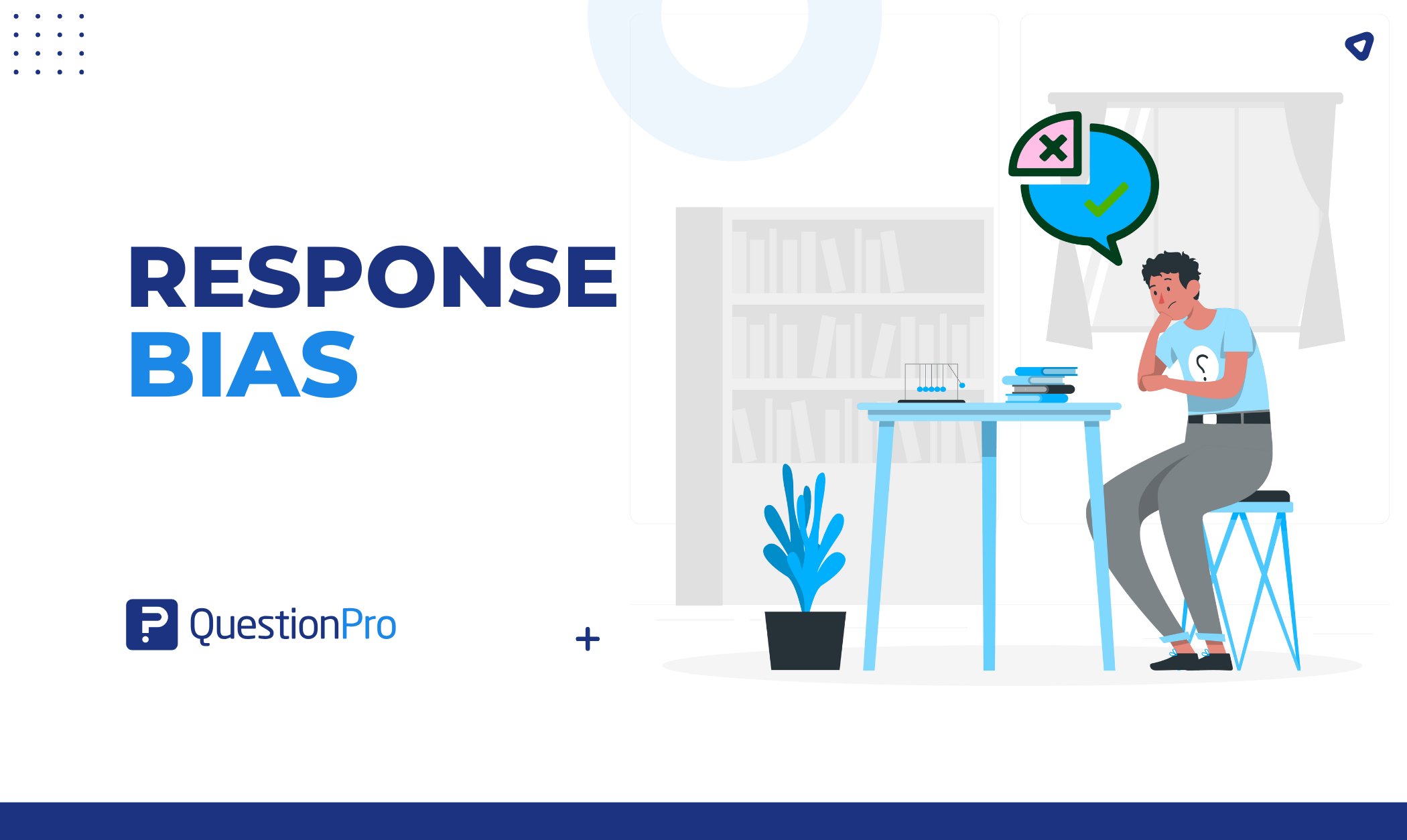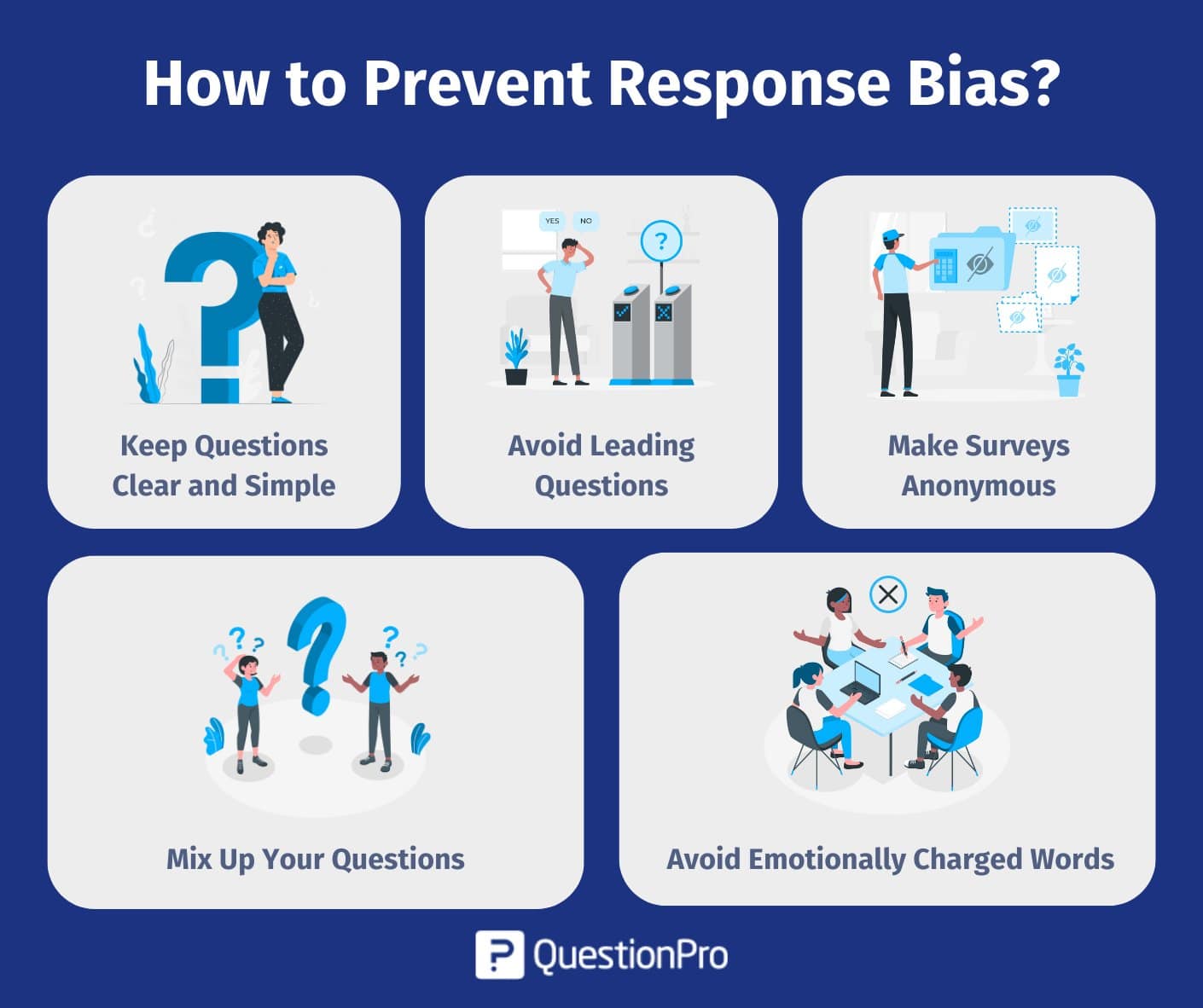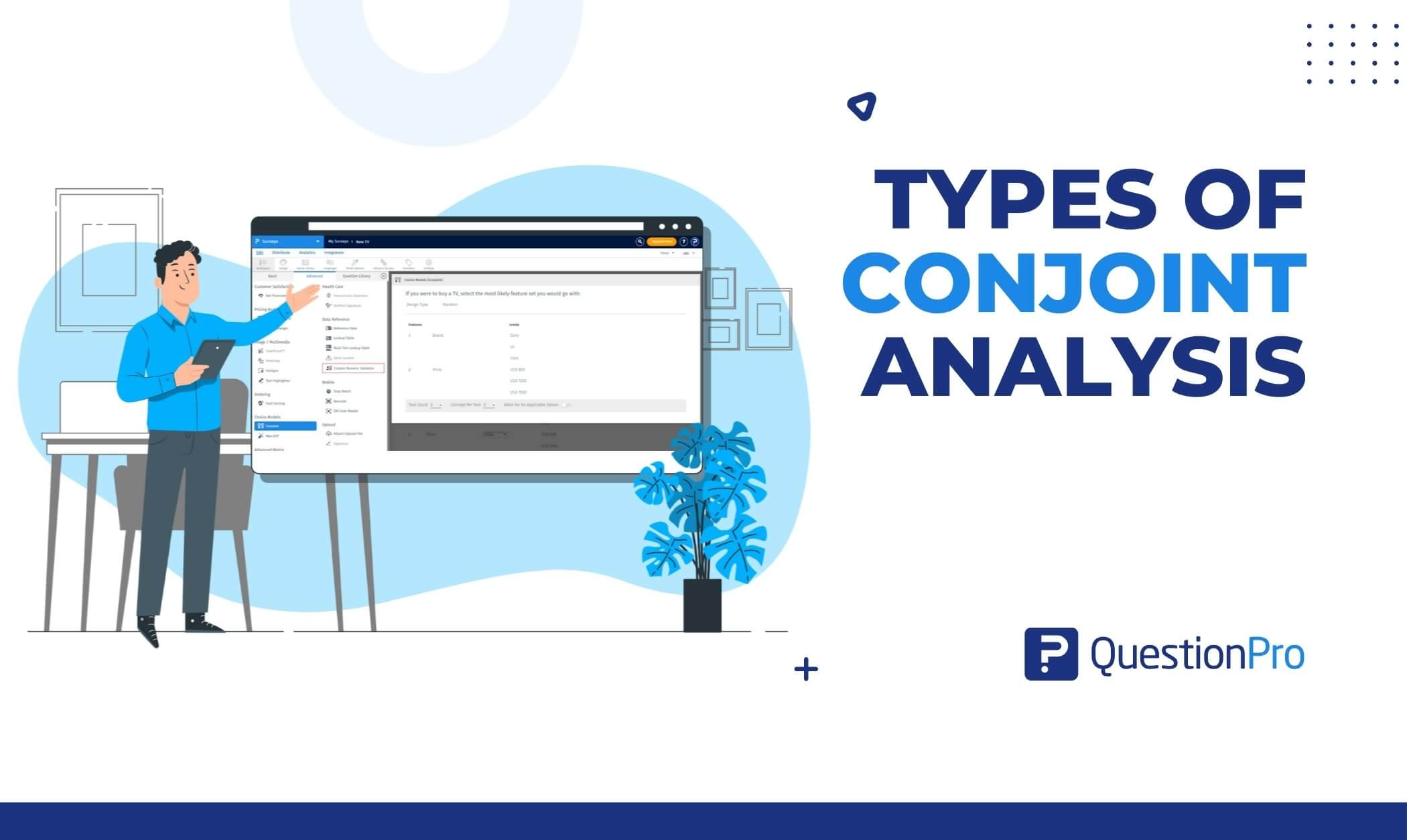
Have you ever taken a survey or filled out a questionnaire and thought, “I know what they want to hear,” or “I better answer this in a way that sounds good”? If so, you’ve probably experienced response bias. It’s a common phenomenon that can cause inaccurate survey results and make it difficult to get accurate data.
But what exactly is response bias, what causes it, and how can we minimize it? Let’s explore these questions in a way that’s easy to understand.
What is Response Bias?
Response bias is a type of survey error that happens when people give answers that don’t truly reflect what they think, feel, or do. Instead of being completely honest, they might choose answers they believe are more acceptable, popular, or expected, even if those answers aren’t true for them.
This survey bias can show up for many reasons. Sometimes, people want to present themselves in a good light (this is called social desirability bias). Other times, they might not fully understand the question, feel uncomfortable answering honestly, or just rush through the survey without thinking much.
When response bias occurs, the survey data becomes unreliable. It paints a false picture of what people really think or feel, which can lead to poor decisions based on incorrect information.
Learn More: Research bias and its impact on the research process.
What Causes Response Bias?
Response bias happens when people don’t give completely honest or accurate answers in a survey. This can happen for many different reasons—some intentional, some not. Let’s look at a few common causes:
1. Wanting to Look Good (Social Pressure)
Sometimes, people answer in a way that makes them look better in the eyes of others. For example, if a survey asks, “Do you always recycle?” someone might say “yes” just because they feel that’s the socially acceptable answer, even if they don’t always do it.
2. Confusing or Leading Questions Cause Response Bias
The way a question is written can lead people to answer a certain way. If a question is too complicated or seems to push a certain opinion, people might get confused or feel pressured to agree, even if that’s not how they really feel. Use neutral wording and avoid complex survey questions like “Don’t you agree our customer service is excellent?” Avoiding these, you can ask simple rating questions like “How would you rate our customer service?”
3. Guessing What the Survey Is About
If someone figures out what the survey is trying to find out, they might change their answers to match what they think the researcher wants. This is called demand bias. Demand characteristics are not always on purpose, but they still affect the results.
3. Not Paying Attention and Long Survey
Not everyone takes surveys seriously. Some people just click through quickly without thinking, especially if the survey is long or boring. This leads to neutral or random answers that aren’t helpful.
4. Cultural and Personal Beliefs Can Cause Bias
People from different backgrounds may understand and answer questions differently.
For example, in some cultures, it might be rude to strongly disagree, so people might always choose softer answers.
5. Trying to Please the Researcher
Some participants just want to be agreeable. They might say yes to most questions, even if they don’t fully agree. This is called acquiescence bias, and it can distort the survey results.
Learn More: How to Identify Reference Bias and Reduce It in Surveys and Research
Why does Response Bias Matter?
Response bias might not seem like a big deal at first, but it can actually cause real problems, especially when you’re trying to make decisions based on survey results. Here’s why it really matters:
- You get the wrong information: If people aren’t answering truthfully, the results won’t show how they really feel or what they actually do. That means you’re working with data that’s misleading.
- Bad data leads to bad decisions: Let’s say a company runs a survey asking employees if they’re happy at work. If most people say yes just to avoid conflict, even though they’re not, the company might think everything’s fine and never make needed improvements.
- It wastes time and money: Surveys take effort to create, send, and analyze. But if it is inaccurate survey responses, that whole process ends up being a waste. You’re investing in something that won’t give you useful answers.
- It hides real problems: When people give safe answers, real issues stay hidden. This can be dangerous, especially in areas like healthcare, customer feedback, or workplace safety.
Types of Response Bias
Response bias can show up in many different ways, and each type can affect the quality of your survey results. When you understand these different types, it becomes easier to spot them early and design better surveys. Let’s break down the most common ones in a simple way:
1. Demand Bias
This happens when people try to guess what the survey is really about and change their answers to match what they think the researcher wants. They may do this without even realizing it, just because they know they’re part of a study.
2. Extreme Response Bias
Here, people only pick the most extreme options on a scale (like always choosing “1” or “5” instead of something in the middle). This can happen due to:
- Strong opinions
- Emotions
- Culture or
- How the questions are worded
3. Neutral Response Bias
This is the opposite of extreme responses. Some people select the middle or neutral option for every question, not because that’s how they feel, but because they’re not really engaged or just want to finish quickly.
4. Acquiescence Bias
Also known as the yes bias, this happens when someone agrees with every statement, even when some of them may go against each other. It could be because they want to please the researcher or simply aren’t thinking deeply about their answers.
5. Dissent Bias
This is the opposite of acquiescence bias. Here, people disagree with everything, often just to be difficult or because of a generally negative attitude toward the survey.
Learn More: How to Identify Data Bias and Reduce It in Surveys and Research
How to Prevent Response Bias?
Avoiding response bias is all about creating surveys that people can answer honestly and comfortably. The goal is to make sure your questions don’t influence survey responses and don’t generate inaccurate or false answers, so you get real, useful answers. Here are some simple ways to do that:

1. Keep Questions Clear and Simple
Complicated or confusing questions can lead to misunderstandings. Use everyday language and keep your questions short and easy to follow. If people don’t understand the question, their answers probably don’t generate accurate results.
2. Avoid Leading Questions
Don’t suggest an answer to your question. For example, instead of asking, “How great was your experience with our service?” ask, “How would you rate your experience with our service?” Neutral questions help people share their real thoughts.
3. Make Surveys Anonymous
When people know their answers are private, they’re more likely to be honest, especially with sensitive topics. Avoid asking for personal info unless it’s absolutely necessary.
4. Mix Up Your Questions
If you ask the same type of question over and over, people may fall into a pattern, like always saying “yes” or choosing the middle option. Mix different styles of questions to keep things fresh and thoughtful.
5. Avoid Emotionally Charged Words
Some words can trigger strong feelings and make people respond emotionally instead of honestly. Try to keep your tone neutral and avoid words that feel judgmental or dramatic.
Learn More: Understanding Sampling Bias and How to Avoid It
Real-World Examples of Response Bias
Response bias shows up more often than we think, especially in everyday surveys and in conducting research. Here are a few real-world examples that help explain how it happens:
1. Job Satisfaction Surveys at Work
Let’s say a company sends out an anonymous survey asking employees how happy they are with their managers. Even though it’s supposed to be private, some employees might still worry that their answers could be traced back to them. So, instead of saying what they really think, they rate their manager more positively. This is a form of social desirability bias, where people give answers they think are more acceptable.
2. Healthcare Surveys
In a hospital, patients are often asked to rate the care they receive. If the survey is given by a nurse or doctor who treated them, the patient may feel pressured to give a good review, even if they had complaints. This is a type of demand bias where the presence of the person asking affects the response.
Survey research methods can also help identify and address the risks of these common demand characteristics to improve the accuracy of the feedback.
3. Political Polls
In political surveys, people may hesitate to admit their real opinions if they feel their views are unpopular or could be judged.
For example, during elections, some voters may not say who they truly support, especially if they think their answer might offend the interviewer. This causes response bias, leading to inaccurate data and poll results.
4. Customer Feedback Forms
After a meal at a restaurant, you’re handed a short form to rate the service. If the waiter is standing right there or hands you a pen with a big smile, you might feel bad giving anything less than a great review. This kind of response bias can make it seem more positive than it really is.
Learn More: Types of Selection Bias and Examples
How does QuestionPro help in Reducing Response Bias?
Response bias can easily sneak into surveys, making results less reliable. But with the right tools, like QuestionPro, you can reduce this bias and get more honest, accurate answers. Here’s how QuestionPro helps:
- Anonymous Surveys: QuestionPro lets you create anonymous surveys, which means people don’t have to worry about their responses being linked back to them. When respondents feel safe, they’re more likely to answer truthfully.
- Randomizing Questions and Answers: Sometimes, the order of questions or choices can influence answers. QuestionPro allows you to randomize them, so there’s no pattern that nudges people toward a certain response.
- Skip Logic and Branching: Not every question fits every person. With skip logic and branching, people only see questions that are relevant to them. This helps avoid confusion and makes their answers more accurate.
- Neutral Wording Tools: QuestionPro offers tools and templates that help you write clear, unbiased questions. When questions are neutral, respondents don’t feel pushed toward any specific answer.
- Multiple Response Types: Different people are comfortable with different styles of answering. QuestionPro supports text boxes, rating scales, dropdowns, and more, so you can match the question style to the topic, making it easier for respondents to share their true thoughts.
- Pre-Survey Testing: Before launching a big survey, you can test it out with a smaller group. This helps extreme responding and catches any wording or structure issues that might lead to response bias.
Learn More: Reporting Bias and Its Overall Impact
Conclusion
We have learned that response bias is a common challenge in surveys, where people’s answers don’t always reflect their true thoughts or feelings. Whether it’s wanting to look good, misunderstanding questions, or simply rushing through, these biases can seriously affect the quality of your data collection.
By understanding the different types of response bias and knowing what causes them, you can design better surveys that encourage honest and accurate answers.
Tools like QuestionPro can help reduce bias through anonymous surveys, smart question design, and thoughtful response options. Ultimately, avoiding response bias means getting clearer insights and making smarter decisions based on real feedback.
Frequently Asked Questions (FAQs)
Answer: Response bias can be caused by factors like question wording, social pressure, the desire to give a “right” answer, or rushing through a survey.
Answer: Response bias can lead to misleading results, making it harder to draw accurate conclusions or make good decisions based on the data.
Answer: Common types include social desirability bias, acquiescence bias, extreme response bias, and non-response bias.
Answer: To reduce response bias, you can write clear and neutral questions, ensure anonymity, and use randomized answer orders or balanced response scales.
Answer: Understanding response bias helps researchers design better surveys and collect more honest, useful feedback.







